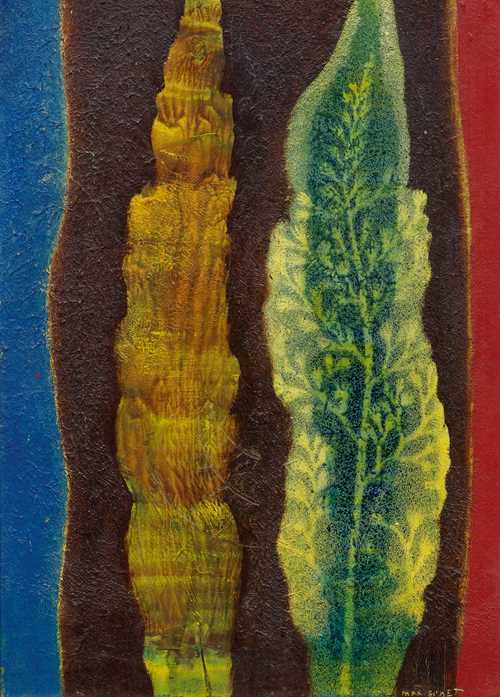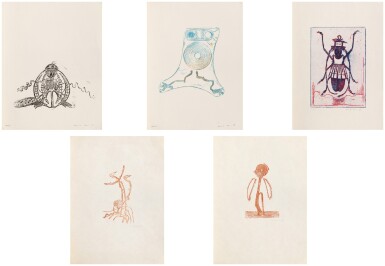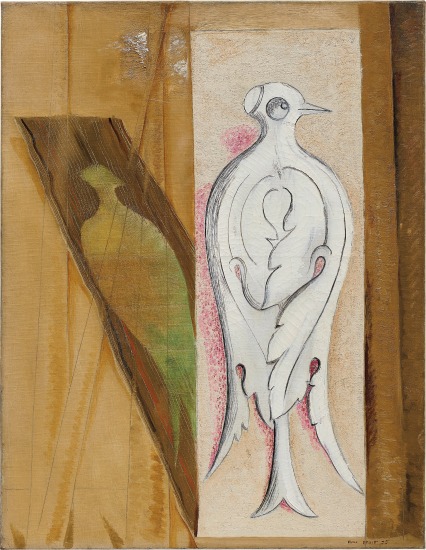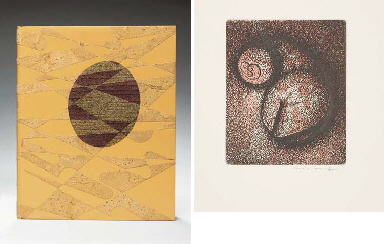Max Ernst Follow Clouds, Sun and Sea oil on Masonite 13 3/8 x 19 1/4 in. (34 x 48.9 cm.) Painted in 1952.
Provenance Alexander Iolas Gallery, New York Dominique de Menil, Houston Acquired thence by descent from the above Exhibited Honolulu Academy of Arts, Paintings by Max Ernst and Dorothea Tanning , July 3 - 27, 1952 Hamburg, Hamburger Kunsthalle; Hannover, Kestner Gesellschaft; Frankfurt, Frankfurter Kunstverein; Berlin, Akademie der Künste; Cologne, Kunsthalle Köln; Paris, Orangerie des Tuileries; Marseille, Musée Cantini; Grenoble, Maison de la Culture; Strasbourg, Ancienne Douane; Nantes, Musée des Beaux-Arts; Houston, Institute for the Arts, Rice University; Dallas Museum of Fine Arts; Kansas City, William Rockhill Nelson Gallery and Mary Atkins Museum of Fine Arts; Art Institute of Chicago; New York, Solomon R. Guggenheim Museum; Cambridge, Busch-Reisinger Museum, Harvard University; Paris, Grand Palais, Max Ernst Inside the Sight , May 14, 1970 - August 15, 1975, no. 57, p. 96 (illustrated) Literature Werner Spies, Max Ernst Oeuvre-Katalog Werke 1939-1953 , Cologne, 1987, no. 2967, p. 334 (illustrated) Catalogue Essay Max Ernst’s Clouds, Sun and Sea is a captivating and fiery dream-like landscape painted in 1952 while the artist was living in Sedona, Arizona. Following the dissolution of his third marriage to collector and gallerist Peggy Guggenheim and his move to New York in 1941, Ernst married fellow artist Dorothea Tanning in 1946, moving out west that same year, where the duo would be based until 1953. By this time, the artist was already internationally acclaimed as a pioneer of both the Dada movement and Surrealism, and this relocation inspired a shift in Ernst’s preferred subject matter from foreboding landscapes and petrified cities to natural scenes in brighter palettes. The year of 1952 also marked a number of exciting professional opportunities for Ernst, including an exhibition at the Contemporary Art Association, Houston and a visit from French surrealist artist Yves Tanguy During the summer, Ernst and Tanning spent a few months in Honolulu, where Ernst led a course of nearly thirty lectures about modern art at the University of Hawaii. Both Ernst and Tanning produced many works while in Hawaii, and the present lot—with a warm sun bathing the ocean and sky with an orange glow—is reminiscent of their stay, likely executed while on the island. In July of that summer, Clouds, Sun and Sea hung on the walls of the Honolulu Academy of Arts in a joint exhibition with Tanning, marking its first reveal to the public. Though by 1952 Ernst had moved away from the Surrealist group, the unique tactile and abstract quality of this work can be traced back to his groundbreaking practice in the mediums of painting, collage and printmaking in the early part of his career. The present lot is reminiscent of Ernst’s series of Forest and Sun works from the 1920s, which utilized his invention of frottage , a technique of rubbing paper over variously textured materials to achieve unforeseen visual effects. Ernst later applied this method to painting with grattage , which translates to “scraping”. These techniques were important contributions to the Surrealist movement and facilitated Ernst’s balance of accidental abstraction and detailed naturalism in his landscapes, a tension which preoccupied the artist from the very beginning of his career. Ernst’s unique treatment of materials instills Clouds, Sun and Sea with a palpable complexity. Thin pigments of black and red are applied to a richly textured Masonite surface, revealing the grain beneath. This perceptible surface quality was likely achieved through the scraping away of oil paint atop a circular object used to create the sun, and a straight edge to mimic the horizon line beneath it. The resulting image is a uniquely abstract interpretation of a naturalistic scene, defined not by its basis in reality but its interpretative, interwoven colors as they collide on the Masonite’s surface. As John Russell espoused of Ernst’s unique depictions of his natural surroundings, “Nature’s
Max Ernst Follow Clouds, Sun and Sea oil on Masonite 13 3/8 x 19 1/4 in. (34 x 48.9 cm.) Painted in 1952.
Provenance Alexander Iolas Gallery, New York Dominique de Menil, Houston Acquired thence by descent from the above Exhibited Honolulu Academy of Arts, Paintings by Max Ernst and Dorothea Tanning , July 3 - 27, 1952 Hamburg, Hamburger Kunsthalle; Hannover, Kestner Gesellschaft; Frankfurt, Frankfurter Kunstverein; Berlin, Akademie der Künste; Cologne, Kunsthalle Köln; Paris, Orangerie des Tuileries; Marseille, Musée Cantini; Grenoble, Maison de la Culture; Strasbourg, Ancienne Douane; Nantes, Musée des Beaux-Arts; Houston, Institute for the Arts, Rice University; Dallas Museum of Fine Arts; Kansas City, William Rockhill Nelson Gallery and Mary Atkins Museum of Fine Arts; Art Institute of Chicago; New York, Solomon R. Guggenheim Museum; Cambridge, Busch-Reisinger Museum, Harvard University; Paris, Grand Palais, Max Ernst Inside the Sight , May 14, 1970 - August 15, 1975, no. 57, p. 96 (illustrated) Literature Werner Spies, Max Ernst Oeuvre-Katalog Werke 1939-1953 , Cologne, 1987, no. 2967, p. 334 (illustrated) Catalogue Essay Max Ernst’s Clouds, Sun and Sea is a captivating and fiery dream-like landscape painted in 1952 while the artist was living in Sedona, Arizona. Following the dissolution of his third marriage to collector and gallerist Peggy Guggenheim and his move to New York in 1941, Ernst married fellow artist Dorothea Tanning in 1946, moving out west that same year, where the duo would be based until 1953. By this time, the artist was already internationally acclaimed as a pioneer of both the Dada movement and Surrealism, and this relocation inspired a shift in Ernst’s preferred subject matter from foreboding landscapes and petrified cities to natural scenes in brighter palettes. The year of 1952 also marked a number of exciting professional opportunities for Ernst, including an exhibition at the Contemporary Art Association, Houston and a visit from French surrealist artist Yves Tanguy During the summer, Ernst and Tanning spent a few months in Honolulu, where Ernst led a course of nearly thirty lectures about modern art at the University of Hawaii. Both Ernst and Tanning produced many works while in Hawaii, and the present lot—with a warm sun bathing the ocean and sky with an orange glow—is reminiscent of their stay, likely executed while on the island. In July of that summer, Clouds, Sun and Sea hung on the walls of the Honolulu Academy of Arts in a joint exhibition with Tanning, marking its first reveal to the public. Though by 1952 Ernst had moved away from the Surrealist group, the unique tactile and abstract quality of this work can be traced back to his groundbreaking practice in the mediums of painting, collage and printmaking in the early part of his career. The present lot is reminiscent of Ernst’s series of Forest and Sun works from the 1920s, which utilized his invention of frottage , a technique of rubbing paper over variously textured materials to achieve unforeseen visual effects. Ernst later applied this method to painting with grattage , which translates to “scraping”. These techniques were important contributions to the Surrealist movement and facilitated Ernst’s balance of accidental abstraction and detailed naturalism in his landscapes, a tension which preoccupied the artist from the very beginning of his career. Ernst’s unique treatment of materials instills Clouds, Sun and Sea with a palpable complexity. Thin pigments of black and red are applied to a richly textured Masonite surface, revealing the grain beneath. This perceptible surface quality was likely achieved through the scraping away of oil paint atop a circular object used to create the sun, and a straight edge to mimic the horizon line beneath it. The resulting image is a uniquely abstract interpretation of a naturalistic scene, defined not by its basis in reality but its interpretative, interwoven colors as they collide on the Masonite’s surface. As John Russell espoused of Ernst’s unique depictions of his natural surroundings, “Nature’s









.jpg)
.jpg?w=400)




Try LotSearch and its premium features for 7 days - without any costs!
Be notified automatically about new items in upcoming auctions.
Create an alert